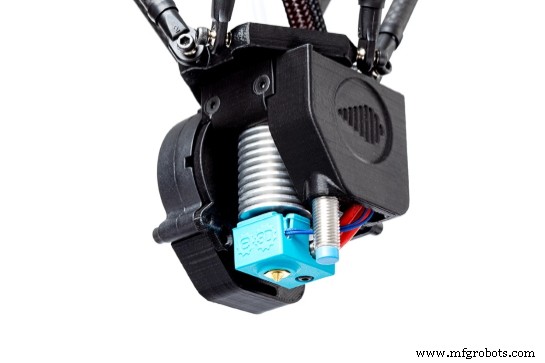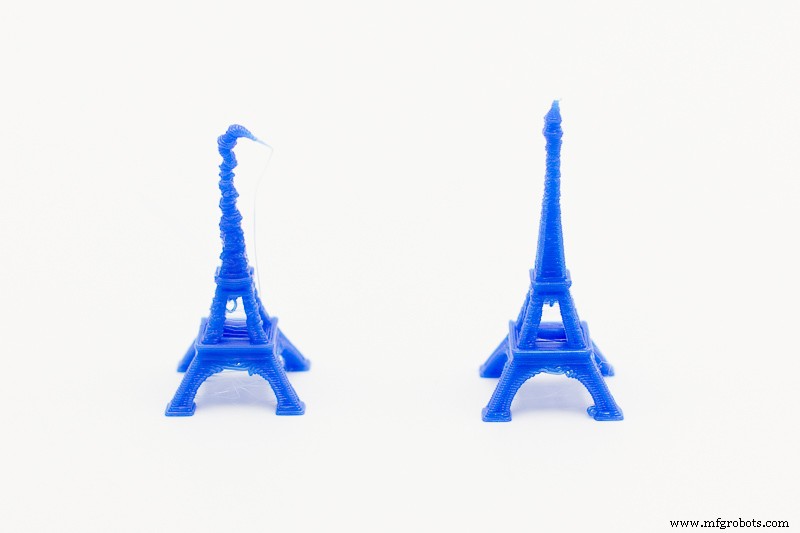Die Bedeutung des Ebenenfächers

Wenn es um die funktionellen Teile eines FDM-3D-Druckers geht, ist der Layer-Lüfter eine der wichtigsten Komponenten das lässt sich finden. Ein 3D-Drucker hat normalerweise zwei Lüfter im HotEnd-Bereich, einen, der für die Kühlung des HotEnd-Diffusors zuständig ist, und einen anderen, der das Material kühlt, das aus der Düse kommt. In diesem Artikel werden wir über letzteres sprechen, den Layer-Fan.
Wann ist es notwendig
Alle Benutzer haben versucht, ein Teil mit kleinen Flächenzonen zu drucken, bei denen sich die Düse ständig in derselben Zone bewegt, ein Prozess, der eine Temperaturüberschreitung verursacht, die das Teil weicher macht. Das gleiche passiert beim Drucken von hohen, schlanken Teilen, wie z. B. einem Zylinder mit kleinem Durchmesser, wo sich Hitze im selben Bereich ansammelt und das Teil katastrophal verformt. Eine weitere typische Verformung ist diejenige, die bei sehr steilen Auslegern auftritt wo das noch heiße Material durch Schweben in der Luft verformt wird, bis es sich verfestigt.
All diese Probleme sind gelöst ganz einfach mit dem Ebenenfächer richtig.

Bild 1:Kleinteile ohne und mit Schichtlüfter.
Kompatible Materialien
Bevor der Benutzer kommentiert, wie der Schichtenfächer konfiguriert wird, muss der Benutzer berücksichtigen, mit welchen Materialien und mit welchen Materialien es empfohlen wird, den Schichtenfächer zu verwenden was nicht.
PLA
Das PLA ist das Material schlechthin, das der Layer-Fan braucht , aufgrund seines niedrigen Erweichungspunktes. Das bedeutet, wenn die Düse für kurze Zeit an der gleichen Stelle platziert wird, wird das Teil irreversible Verformungen erleiden. Aus diesem Grund ist der Schichtlüfter eine entscheidende Komponente in allen FDM-3D-Druckern, die PLA oder ein Verbundmaterial verwenden, das dieses Polymer als Basis enthält.
ABS
This material and similar ones, such as ASA, are totally incompatible with the layer fan . This is because the ABS is very sensitive to the loss of temperature against drafts, such sharp increases that cause cracking (delamination of the layers) and the total failure of printing. For this reason, it is vital to use ABS and ASA with fully closed 3D printers.
Others
Apart from the materials discussed above, in 3D FDM printing there are many more types of filaments and each with a different print configuration, for that reason a table with the majority of available materials is shown below and it is indicated if they need or no layer fan:
| Material | Layer fan |
|---|---|
| PLA | Yes |
| ABS | No |
| Flexible | Yes |
| HiPS | No |
| PETG | Yes |
| Nylon | No |
| ASA | No |
| PC | No |
| PP | Yes |
| PVA | Yes |
Table 1:Layer fan depending on the material.
Expert Advice
Once the user already knows whether or not he needs to use the layer fan, he must know how to use it and when.
At the beginning of a print the user needs the first layer to adhere to the base with sufficient firmness so that it does not peel off during printing. This is achieved, not only using some product that improves adhesion, but also keeping the temperature stable, so the layer fan must be turned off during the first two layers . Once the print has a certain height, the speed of the layer fan must be adjusted to the geometry of the piece in each layer. In general, there are two cases where the speed must be varied:when the printing time of a layer is greater than 5 seconds and when it is less than 5 seconds. In the first case, the layer fan speed must be increased linearly from 70% with layer times of 20 seconds or more, up to 100% with layers of 5 seconds. When the layer time is less than 5 seconds , the user must use the layer fan at 100% speed , sometimes being an insufficient speed that causes deformation in the part. This problem, which usually occurs when narrow and tall pieces are made, is solved by printing several separate pieces simultaneously as much as possible so that each layer has time to cool.
Any lamination software (Cura3D, Simplify3D, Slic3r...) allows you to modify the speed of the layer fan at the height of the piece that the user wants.

Image 2:Configure layer fan in Simplify3D. Source:Simplify3D.
Schlussfolgerung
It is important that all users of a 3D FDM printer know how to use the layer fan correctly, as it is a complement that elevates the quality and complexity of the parts.
3d Drucken
- Die Bedeutung der elektrischen Sicherheit
- Die Bedeutung von Kernkompetenzen
- Die Bedeutung von Trends bei der Zuverlässigkeit von Elektromotoren
- Die Bedeutung der routinemäßigen Wartung von Geräten
- Die Bedeutung der schnellen Bearbeitung in der Fertigung
- Die Bedeutung der Ursachenanalyse
- Die Bedeutung der Notfallplanung
- Die Bedeutung der Interoperabilität in 3D-Softwareanwendungen
- Die Bedeutung der von Startups entwickelten Technologie
- Die Bedeutung von Wasser



